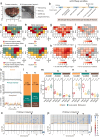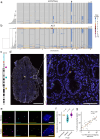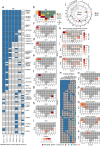High clonal diversity and spatial genetic admixture in early prostate cancer and surrounding normal tissue
- PMID: 38658552
- PMCID: PMC11043350
- DOI: 10.1038/s41467-024-47664-z
High clonal diversity and spatial genetic admixture in early prostate cancer and surrounding normal tissue
Abstract
Somatic copy number alterations (SCNAs) are pervasive in advanced human cancers, but their prevalence and spatial distribution in early-stage, localized tumors and their surrounding normal tissues are poorly characterized. Here, we perform multi-region, single-cell DNA sequencing to characterize the SCNA landscape across tumor-rich and normal tissue in two male patients with localized prostate cancer. We identify two distinct karyotypes: 'pseudo-diploid' cells harboring few SCNAs and highly aneuploid cells. Pseudo-diploid cells form numerous small-sized subclones ranging from highly spatially localized to broadly spread subclones. In contrast, aneuploid cells do not form subclones and are detected throughout the prostate, including normal tissue regions. Highly localized pseudo-diploid subclones are confined within tumor-rich regions and carry deletions in multiple tumor-suppressor genes. Our study reveals that SCNAs are widespread in normal and tumor regions across the prostate in localized prostate cancer patients and suggests that a subset of pseudo-diploid cells drive tumorigenesis in the aging prostate.
© 2024. The Author(s).
Conflict of interest statement
The authors declare no competing interests.
Figures




References
-
- Knouse KA, Davoli T, Elledge SJ, Amon A. Aneuploidy in cancer: seq-ing answers to old questions. Annu. Rev. Cancer Biol. 2017;1:335–354. doi: 10.1146/annurev-cancerbio-042616-072231. - DOI
Publication types
MeSH terms
Grants and funding
LinkOut - more resources
Full Text Sources
Medical

